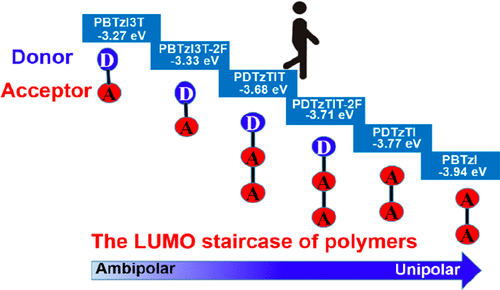当前位置:
X-MOL 学术
›
Chem. Mater.
›
论文详情
Our official English website, www.x-mol.net, welcomes your
feedback! (Note: you will need to create a separate account there.)
Imide-Functionalized Thiazole-Based Polymer Semiconductors: Synthesis, Structure–Property Correlations, Charge Carrier Polarity, and Thin-Film Transistor Performance
Chemistry of Materials ( IF 7.2 ) Pub Date : 2018-10-09 00:00:00 , DOI: 10.1021/acs.chemmater.8b03670 Yongqiang Shi 1, 2 , Han Guo 1 , Minchao Qin 3 , Yuxi Wang 1 , Jiuyang Zhao 1 , Huiliang Sun 1 , Hang Wang 1 , Yulun Wang 1 , Xin Zhou 1 , Antonio Facchetti 4 , Xinhui Lu 3 , Ming Zhou 2 , Xugang Guo 1
Chemistry of Materials ( IF 7.2 ) Pub Date : 2018-10-09 00:00:00 , DOI: 10.1021/acs.chemmater.8b03670 Yongqiang Shi 1, 2 , Han Guo 1 , Minchao Qin 3 , Yuxi Wang 1 , Jiuyang Zhao 1 , Huiliang Sun 1 , Hang Wang 1 , Yulun Wang 1 , Xin Zhou 1 , Antonio Facchetti 4 , Xinhui Lu 3 , Ming Zhou 2 , Xugang Guo 1
Affiliation

|
Imide-functionalized arenes, exemplified by naphthalene diimides (NDIs), perylene diimides (PDIs), and bithiophene imides (BTIs), are the most promising building blocks for constructing high-performance n-type polymers. In order to reduce the steric hindrance associated with NDI- and PDI-based polymers and to address the high-lying LUMO issue of BTI-based polymers, herein a highly electron-deficient imide-functionalized bithiazole, N-alkyl-5,5′-bithiazole-4,4′-dicarboximide (BTzI), was successfully synthesized via an efficient C–H activation. Single crystal of BTzI model compound showed a planar backbone with close π-stacking distances (3.2–3.3 Å). The N,N′-bis(2-alkyl)-2,2′-bithiazolethienyl-4,4′,10,10′-tetracarboxdiimide (DTzTI) was also used for constructing polymer semiconductors. Compared to DTzTI, BTzI is more electron-deficient, rendering it highly appealing for enabling n-type polymers. On the basis of BTzI and DTzTI, a series of polymers, including acceptor–acceptor homopolymers, and donor–acceptor and donor–acceptor–acceptor copolymers, were synthesized, which feature different contents of acceptor units in polymeric backbones. As imide content increases, the polymer FMO levels were gradually lowered, yielding a transition of charge carrier from ambipolarity to unipolar n-type in organic thin-film transistors (OTFTs). The acceptor–acceptor homopolymer PBTzI possesses the deepest LUMO/HOMO level of −3.94/-6.17 eV, enabling minimal off-current (Ioff) of 10–10–10–11 A in OTFTs. The highest electron mobility of 1.61 cm2 V–1 s–1 accompanied by small Ioff of 10–10–10–11 A and high on-current/off-current ratio (Ion/Ioff) of 107–108 was achieved from OTFTs using PDTzTI homopolymer, showing the pronounced advantages of acceptor-acceptor homopolymer approach for developing unipolar n-type polymer semiconductors. The correlations between the FMO levels and the transistor performances underscore the significance of FMO tuning for enabling unipolar electron transport. The results demonstrate that imide-functionalized thiazoles are excellent units for constructing high-performance n-type polymers. Moreover, the synthetic routes to these highly electron-deficient imide-functionalized thiazoles and the polymer structure–property correlations developed here are informative for materials invention in organic electronics.
中文翻译:

酰亚胺功能化的基于噻唑的聚合物半导体:合成,结构性质相关,电荷载流子极性和薄膜晶体管性能
酰亚胺官能化的芳烃,例如萘二酰亚胺(NDI),per二酰亚胺(PDI)和联噻吩酰亚胺(BTI),是构建高性能n型聚合物的最有希望的基础。为了减少与基于NDI和PDI的聚合物相关的位阻,并解决基于BTI的聚合物的高度LUMO问题,本文中使用高度电子不足的酰亚胺官能化的噻唑N-烷基-5,5' -bithiazole -4,4'-二苯甲酰亚胺(BTzI),是通过有效的C–H活化成功合成的。BTzI模型化合物的单晶显示出一个平坦的骨架,具有接近的π堆积距离(3.2-3.3Å)。该ñ,ñ'-双(2-烷基)-2,2'-噻唑基噻吩-4,4',10,10'-四羧二酰亚胺(DTzTI)也用于构建聚合物半导体。与DTzTI相比,BTzI更缺乏电子,使其对于启用n型聚合物具有很高的吸引力。基于BTzI和DTzTI合成了一系列聚合物,包括受体-受体均聚物,供体-受体和供体-受体-受体共聚物,这些聚合物在聚合物主链中具有不同的受体单元含量。随着酰亚胺含量的增加,聚合物FMO含量逐渐降低,从而使有机薄膜晶体管(OTFT)中的载流子从双极性转变为单极性n型。受体-受体均聚物PBTzI具有-3.94 / -6.17电子伏特的最深LUMO / HOMO能级,从而使最小截止电流(我关10)-10 -10 -11在OTFT中甲。最高电子迁移率为1.61 cm 2 V –1 s –1,伴随着较小的电子迁移率我关10 -10 -10 -11 A和高导通电流/截止电流比(我上/我关的10)7 -10 8是从使用的OTFT实现PDTzTI均聚物,显示出受体-受体均聚物方法在开发单极性n型聚合物半导体方面的显着优势。FMO电平与晶体管性能之间的相关性突显了FMO调整对于实现单极电子传输的重要性。结果表明,酰亚胺官能化的噻唑是构建高性能n型聚合物的极好单元。而且,合成这些高度缺电子的酰亚胺官能化的噻唑的途径以及此处开发的聚合物结构与性质的相关性,对于有机电子学中的材料发明是有益的。
更新日期:2018-10-09
中文翻译:

酰亚胺功能化的基于噻唑的聚合物半导体:合成,结构性质相关,电荷载流子极性和薄膜晶体管性能
酰亚胺官能化的芳烃,例如萘二酰亚胺(NDI),per二酰亚胺(PDI)和联噻吩酰亚胺(BTI),是构建高性能n型聚合物的最有希望的基础。为了减少与基于NDI和PDI的聚合物相关的位阻,并解决基于BTI的聚合物的高度LUMO问题,本文中使用高度电子不足的酰亚胺官能化的噻唑N-烷基-5,5' -bithiazole -4,4'-二苯甲酰亚胺(BTzI),是通过有效的C–H活化成功合成的。BTzI模型化合物的单晶显示出一个平坦的骨架,具有接近的π堆积距离(3.2-3.3Å)。该ñ,ñ'-双(2-烷基)-2,2'-噻唑基噻吩-4,4',10,10'-四羧二酰亚胺(DTzTI)也用于构建聚合物半导体。与DTzTI相比,BTzI更缺乏电子,使其对于启用n型聚合物具有很高的吸引力。基于BTzI和DTzTI合成了一系列聚合物,包括受体-受体均聚物,供体-受体和供体-受体-受体共聚物,这些聚合物在聚合物主链中具有不同的受体单元含量。随着酰亚胺含量的增加,聚合物FMO含量逐渐降低,从而使有机薄膜晶体管(OTFT)中的载流子从双极性转变为单极性n型。受体-受体均聚物PBTzI具有-3.94 / -6.17电子伏特的最深LUMO / HOMO能级,从而使最小截止电流(我关10)-10 -10 -11在OTFT中甲。最高电子迁移率为1.61 cm 2 V –1 s –1,伴随着较小的电子迁移率我关10 -10 -10 -11 A和高导通电流/截止电流比(我上/我关的10)7 -10 8是从使用的OTFT实现PDTzTI均聚物,显示出受体-受体均聚物方法在开发单极性n型聚合物半导体方面的显着优势。FMO电平与晶体管性能之间的相关性突显了FMO调整对于实现单极电子传输的重要性。结果表明,酰亚胺官能化的噻唑是构建高性能n型聚合物的极好单元。而且,合成这些高度缺电子的酰亚胺官能化的噻唑的途径以及此处开发的聚合物结构与性质的相关性,对于有机电子学中的材料发明是有益的。











































 京公网安备 11010802027423号
京公网安备 11010802027423号